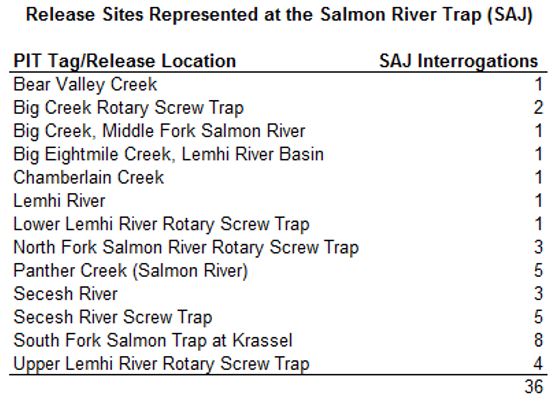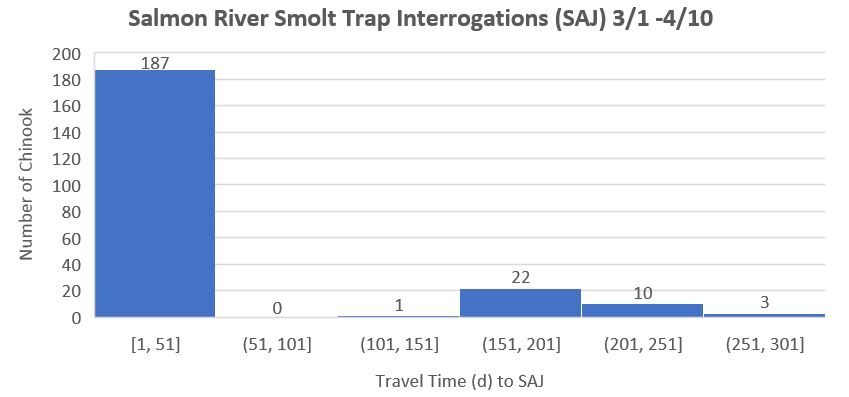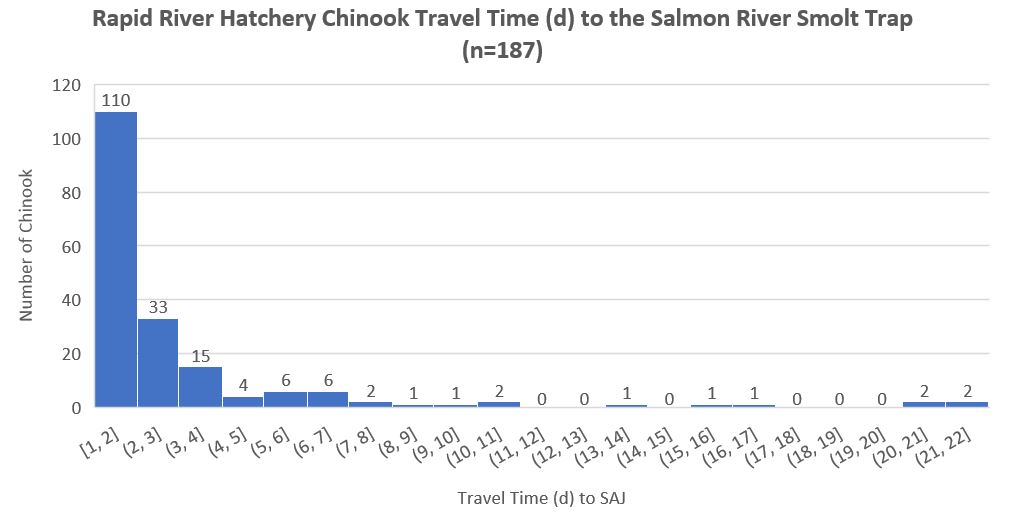The Salmon River fish trap, located near Twin Bridges north of Riggins, has been providing valuable salmon data for more than three decades. Specifically, the trap captures juvenile Chinook salmon (known as smolts) as they migrate to the ocean in the spring. A subset of the fishes is PIT-tagged. The small glass-encapsulated microchip, the size of a rice grain, labels each fish with a unique identifier (like a social security number) that allows fisheries personnel to monitor the downstream journey.
One question biologists and hatchery managers are interested in is, “How closely do hatchery reared smolts mimic natural origin smolt migration timing?” Rapid River hatchery is located south of Riggins, 31 river miles upstream of the smolt trap. Besides contributing tagged fish to monitor passage downstream of it, the Salmon River smolt trap also serves as an interrogation site for fishes PIT-tagged upstream. Consequently, it can help answer this and other questions. “SAJ” (Salmon River Juvenile) is the Salmon River smolt trap interrogation system identifier.
Since March 1st, 36 natural origin Chinook smolts that were PIT-tagged at sites upstream of the Salmon River trap have been interrogated. These fishes were PIT-tagged and released between 6/24/19 and 10/25/19. They were detected at SAJ between 3/16/20 and 4/10/20.

Between March 1st and April 10th, 223 Chinook salmon were interrogated at SAJ. This included 187 Rapid River hatchery smolts and 36 natural origin smolts. Travel times to the trap ranged from one day for most Rapid River smolts to 276 days for one natural origin Chinook tagged on 6/24/19 at the Lemhi River.

The Salmon River smolt trap started 2020 operations on March 1st. Upper Salmon River basin natural origin Chinook smolts were first detected on March 16th. Rapid River hatchery smolts arrived three days later on March 19th. Hatchery and natural origin smolts continued to arrive at similar rates throughout this trapping period. Therefore, Salmon River smolt trap interrogation data suggests that Rapid River hatchery smolt migration timing is similar to that of natural origin smolts.
Another question is, “Do Rapid River hatchery Chinook exit the rearing pond only to remain in local waters until a later date?” An interrogation system at the Rapid River hatchery pond records PIT-tagged Chinook as they exit into Rapid River. Consequently, we can determine the travel time from the hatchery to the smolt trap (31 river miles). The data shows that the majority (59%) of Rapid River hatchery Chinook reach the smolt trap within one day of exiting the pond. Eighty-five percent arrive within three days. So far this year, none have exceeded 22 days between the two sites. Clearly, the data shows most Rapid River Hatchery Chinook exit the rearing pond and immediately begin migrating with the natural fish.

The Salmon River smolt trap interrogation data helps fisheries personnel answer crucial juvenile Chinook management questions. It shows Rapid River hatchery Chinook smolt migration timing is similar to natural origin smolts that rear in upper Salmon River locations. This knowledge helps Chinook salmon managers maintain the same hatchery smolt migration timing as smolts with different rearing origins.
